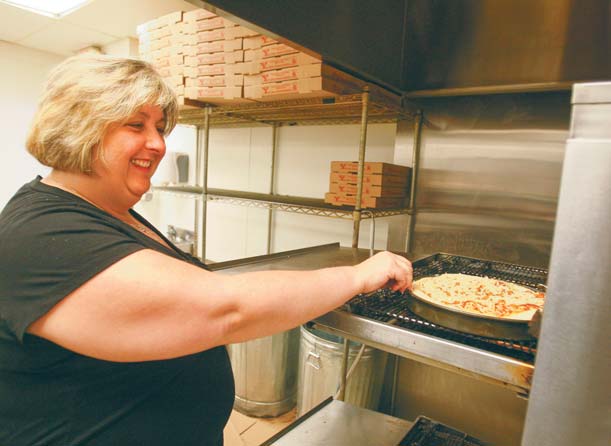Some business owners say minimum wage hike forcing cuts

Minimum-wage increases have taken their toll on some small businesses in Ohio such as Belleria in Cornersburg. Owner Leanne Douglass said she had to close her full-service restaurant because of increasing labor costs.
By Karl Henkel
khenkel@vindy.com
YOUNGSTOWN
Ohio’s new minimum wage, which climbed to $7.70 on Jan. 1, doesn’t appear to be an earth-shattering increase.
On the surface, it’s 30 cents more per hour than in 2010.
That’s an extra $12 a week for a full-time minimum-wage worker, an extra $48 a month and an additional $624 a year, before taxes.
But what is good for the goose is not necessarily good for the gander.
Though about 291,000 Ohio workers will capitalize directly on the wage increase, according to the Economic Policy Institute, thousands of businesses now are forced to pay higher wages.
One of those businesses is the Cornersburg Belleria on Meridian Road in Youngstown.
“I had a full-service restaurant and went down to carry-out delivery,” said Leanne Douglass, owner. “People still don’t understand why. They think anyone who owns a business is making tons of money. They don’t understand our costs at all.”
The Cornersburg Belleria, which had a spacious dining area with bar, was forced to close that section of its location at the end of 2011.
The restaurant is now down to about 10 employees, 20 fewer than its peak last year and well below its all-time high of 45.
“We had a lot of older women helping with the house payments,” said Mark Douglass, co-owner. “It hurt.”
A work-force reduction is nothing new for the Douglasses, owners of the Belleria since 2001.
As part of a constitutional amendment approved by voters in 2006, the minimum wage increases each year at the rate of inflation.
“This is the biggest economic downturn since the Great Depression,” said Mark Douglass. “The timing was awful.”
The minimum wage has jumped five of the past six years.
In 2007, it skyrocketed from $5.15 per hour to $6.85 per hour.
The new 2012 minimum-wage rate of $7.70 applies to workers 16 and older who don’t get tips. The wage for tipped employees is up 15 cents to $3.85.
Their total pay cannot be less than $7.70 hourly.
Employers that gross more than $283,000 annually must comply with the state’s new minimum-wage standards; all others must pay employees a minimum of $7.25 per hour.
Many point to minimum-wage increases as a way to help low-income individuals and families keep up with the cost of living.
According to EPI, Ohio’s minimum-wage increase will result in $76.5 million in increased gross domestic product.
The EPI report says the new minimum-wage standard is expected to create 665 full-time jobs. Those jobs, however, likely will come from additional hours for part-time workers and not actual “new” jobs.
Tod Porter, economics chairman at Youngstown State University, said the minimum-wage debate is, for the most part, overinflated.
“You have a controversial issue creating a lot of interest, but the effects on the ground are pretty modest,” he said.
Porter said minimum-wage increases often have minimal positive effects on poverty rates and minimal negative impacts on employment levels.
“The standard economic theory suggests that an increase in the minimum wage should result in a decrease in the number of hours employed,” Porter said. “A 10 percent increase in minimum wage would result in 1 percent decrease in teenage employment.”
About 28 percent of Ohio workers affected by the minimum-wage increase are under 20, according to Policy Matters Ohio.
About 25 percent of the workers formerly employed at the Cornersburg Belleria were under 20.
The Mahoning Valley has another angle working against it: its proximity to Pennsylvania.
In 2009, Pennsylvania’s minimum wage was 60 cents higher than the wage in Ohio. The Buckeye State minimum wage is now 45 cents higher than that of the Keystone State, which at $7.25 per hour matches the current federal minimum wage.
“I would never open another business in Ohio,” Leanne Douglass said.
Even a Pennsylvania businessman can’t believe the rate at which Ohio’s minimum wage has increased.
“It’s counterproductive,” said Lou Desimone of Cedar Manor Personal Home Care in New Castle, Pa. “Let the market carry itself.”
Porter said, however, that if minimum wage properly followed inflation, the current federal minimum wage should be more than $8 per hour.
There was a decades-long stretch beginning in 1997 when the federal government did not increase the minimum wage, Porter said.
“Minimum wage is not high by historical standards,” he added.
 43
43
